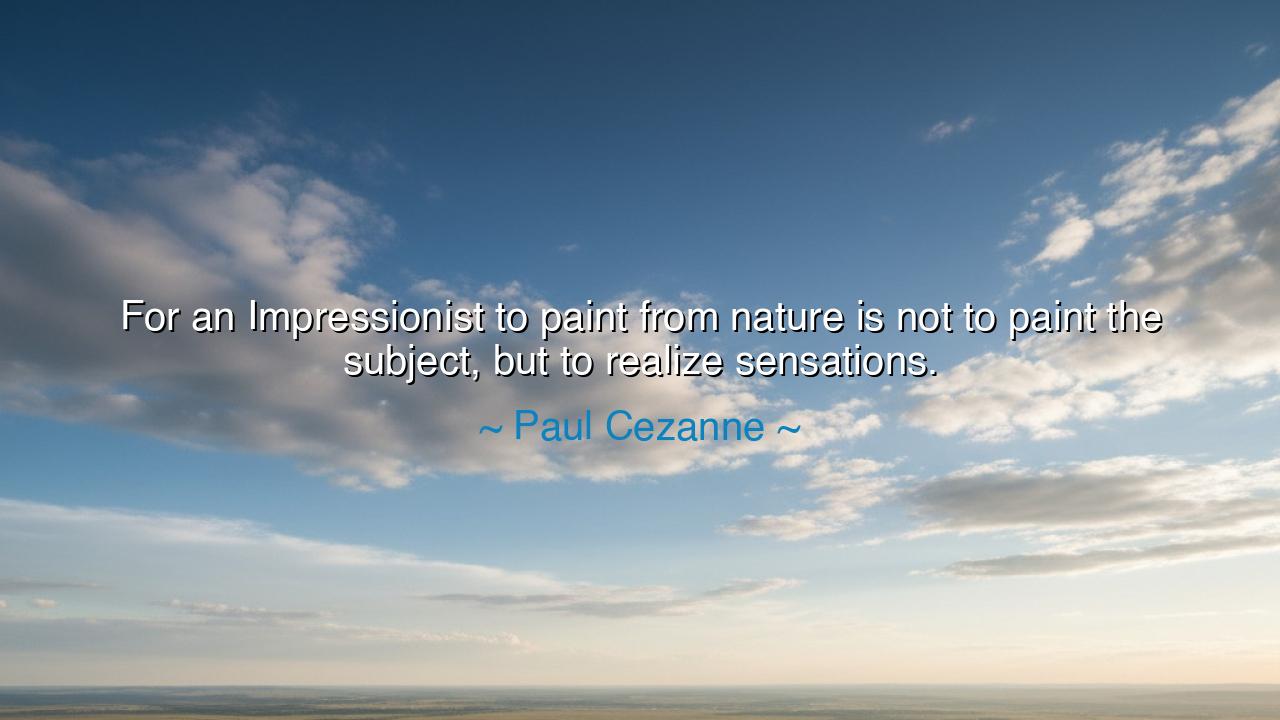
For an Impressionist to paint from nature is not to paint the
For an Impressionist to paint from nature is not to paint the subject, but to realize sensations.






When Paul Cézanne declared, “For an Impressionist to paint from nature is not to paint the subject, but to realize sensations,” he spoke as one who sought to pierce beyond the surface of the visible world. His words reveal that true art does not merely copy what the eyes behold, but seeks to awaken in the soul the sensations—the fleeting impressions, the stirrings of light, the breath of color—that nature inspires within us. For Cézanne and his fellow Impressionists, painting was not the crafting of a mirror but the conjuring of a living experience, as if one were standing in the field, feeling the warmth of the sun and the cool of the wind at once.
The subject of a painting—a tree, a mountain, a woman, a river—was not, in Cézanne’s vision, the true essence of the work. To focus only on the object is to remain on the surface, to grasp the form but not the spirit. Instead, the artist’s task was to capture the pulse beneath the form: the shimmer of light upon the water, the trembling hush of leaves in a breeze, the fire of color at sunset. This is why Cézanne speaks of realizing sensations. The artist translates nature not as a catalog of shapes, but as an unfolding experience, drawn into the heart of the observer.
The ancients too perceived this difference between outer form and inner truth. Plato spoke of the visible world as shadows of higher realities, urging seekers to look beyond mere appearances toward the essence of things. In the same way, Cézanne teaches that the painter’s eye must look beyond the mere outline of nature, searching instead for the living spirit that animates it. Thus, painting becomes philosophy with brush and color, a contemplation of being through the language of light.
History offers us a story to anchor this truth. Consider Claude Monet, painting the same haystacks again and again at dawn, midday, and twilight. To the casual eye, it was one subject repeated endlessly. But Monet was not painting haystacks—he was painting sensations: the cool mist of morning, the blaze of the noonday sun, the golden hush of evening. Each canvas was not a picture of an object, but an evocation of time, light, and mood. Here, the wisdom of Cézanne is revealed: the subject is but a vessel; the true art lies in what it awakens within the soul.
The lesson of this teaching is profound: in life, as in art, do not cling only to the surface of things. Objects, events, and even people are more than their outward forms. Learn to see, feel, and honor the sensations they stir—the unseen dimensions of experience, the tremors of meaning that lie beneath. To live in this way is to live as an artist of life, translating the ordinary into the extraordinary by attending to its inner resonance.
Practically, this wisdom calls us to pay attention. When you walk through a forest, do not merely note the shapes of trees—feel the shifting of light, the scent of earth, the song of birds. When you meet another person, do not see only the form of their face—attend to the warmth of their presence, the rhythm of their voice, the spirit behind their eyes. Train your heart to perceive the sensations that life offers, and you will find beauty in places where others see only routine.
Thus, Cézanne’s words endure as a call to depth: art is not about subjects, but sensations, and life itself, when lived with the eyes of an artist, is a canvas of infinite color. Let us then be not mere recorders of appearances, but seekers of essence. Let us see with the heart as well as the eye, so that every moment, like every brushstroke, becomes a revelation of the living spirit within nature and within ourselves.






AAdministratorAdministrator
Welcome, honored guests. Please leave a comment, we will respond soon